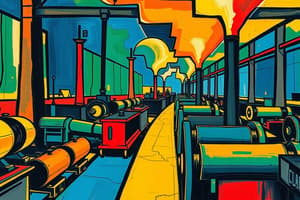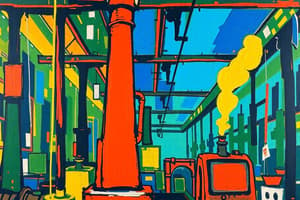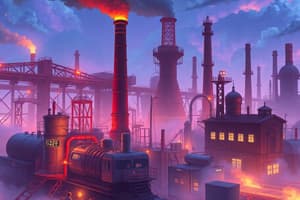Podcast
Questions and Answers
What was the primary factor that led to the significant increase in McCormick's reaper production from 1880 to 1889?
What was the primary factor that led to the significant increase in McCormick's reaper production from 1880 to 1889?
- A decline in the cost of raw materials lowered production costs.
- Government subsidies for agricultural equipment boosted sales.
- The adoption of new marketing strategies increased demand for the reaper.
- The introduction of new, interchangeable parts made production more efficient. (correct)
What is the main reason provided in the text for the United States becoming the world's leading manufacturing nation by 1900?
What is the main reason provided in the text for the United States becoming the world's leading manufacturing nation by 1900?
- The adoption of mass production techniques. (correct)
- The abundance of natural resources.
- The availability of a large and skilled workforce.
- Government regulations that favored domestic manufacturers.
What is the key advantage of mass production mentioned in the passage?
What is the key advantage of mass production mentioned in the passage?
- Lower production costs per unit as output increases. (correct)
- Reduced dependence on skilled labor.
- Increased product quality due to standardized parts.
- Greater efficiency in labor utilization.
Which of the following statements is NOT mentioned as a factor that contributed to the growth of mass production in the United States?
Which of the following statements is NOT mentioned as a factor that contributed to the growth of mass production in the United States?
According to the passage, what was the role of the “visible hand” in the industrial revolution?
According to the passage, what was the role of the “visible hand” in the industrial revolution?
What is the main purpose of the passage's discussion of the corporation’s role in the industrial revolution?
What is the main purpose of the passage's discussion of the corporation’s role in the industrial revolution?
How did the corporation's ability to limit shareholder liability affect industrialization?
How did the corporation's ability to limit shareholder liability affect industrialization?
Based on information in the passage, what is a plausible reason for the significant difference in industrial production between 1860 and 1900?
Based on information in the passage, what is a plausible reason for the significant difference in industrial production between 1860 and 1900?
What was the primary factor that led to the widespread railroad strikes of the post-Civil War era?
What was the primary factor that led to the widespread railroad strikes of the post-Civil War era?
What was the significance of the "Great Upheaval" strikes for the labor movement?
What was the significance of the "Great Upheaval" strikes for the labor movement?
What does the phrase "powerlessness in the coming industrial order" refer to in the text?
What does the phrase "powerlessness in the coming industrial order" refer to in the text?
How did the federal government respond to the strikes?
How did the federal government respond to the strikes?
Which of the following factors contributed to the growth of industrialization in the post-Civil War era?
Which of the following factors contributed to the growth of industrialization in the post-Civil War era?
What was the primary impact of the strikes on businesses?
What was the primary impact of the strikes on businesses?
What was the primary motivation behind the workers' actions in the strikes?
What was the primary motivation behind the workers' actions in the strikes?
What does the term "The Great Upheaval" refer to in the text?
What does the term "The Great Upheaval" refer to in the text?
What was the primary reason behind the "great merger movement" in the late 19th and early 20th centuries?
What was the primary reason behind the "great merger movement" in the late 19th and early 20th centuries?
Which of the following best describes the relationship between investors and corporations during the period discussed in the text?
Which of the following best describes the relationship between investors and corporations during the period discussed in the text?
What was the primary driving force behind the cutthroat competition that threatened early industrial profits?
What was the primary driving force behind the cutthroat competition that threatened early industrial profits?
What is the primary economic principle illustrated by the concept of "economies of scale"?
What is the primary economic principle illustrated by the concept of "economies of scale"?
What is the main impact of the "great merger movement" described in the text?
What is the main impact of the "great merger movement" described in the text?
How did the rise of industrial capitalism impact wealth distribution in America?
How did the rise of industrial capitalism impact wealth distribution in America?
What was a primary challenge faced by corporations during the industrialization era?
What was a primary challenge faced by corporations during the industrialization era?
What was the primary impact of the formation of United States Steel in 1901?
What was the primary impact of the formation of United States Steel in 1901?
What was the main reason for the rise of a vast American labor movement in the last quarter of the nineteenth century?
What was the main reason for the rise of a vast American labor movement in the last quarter of the nineteenth century?
What was the impact of the high protective tariff policy on American industry during the Gilded Age?
What was the impact of the high protective tariff policy on American industry during the Gilded Age?
Which of the following was NOT a consequence of the mechanization and mass production that occurred in American industry during this time?
Which of the following was NOT a consequence of the mechanization and mass production that occurred in American industry during this time?
How did the ideas of Social Darwinism justify national policies during this era?
How did the ideas of Social Darwinism justify national policies during this era?
Which statement best describes the impact of the Civil War and Reconstruction on the labor movement?
Which statement best describes the impact of the Civil War and Reconstruction on the labor movement?
What was the primary motivation for workers participating in strikes during the late nineteenth and early twentieth centuries?
What was the primary motivation for workers participating in strikes during the late nineteenth and early twentieth centuries?
Which of the following accurately describes the economic situation of the typical industrial laborer during this time period?
Which of the following accurately describes the economic situation of the typical industrial laborer during this time period?
Which of the following groups was least likely to support the ideas of Social Darwinism?
Which of the following groups was least likely to support the ideas of Social Darwinism?
What was the main policy that the Republican candidate, William McKinley, campaigned on in his bids for presidency in 1896 and 1900?
What was the main policy that the Republican candidate, William McKinley, campaigned on in his bids for presidency in 1896 and 1900?
What was the significance of the Gold Standard Act passed by Congress in early 1900?
What was the significance of the Gold Standard Act passed by Congress in early 1900?
What did Bryan symbolize in the election of 1896, according to the text?
What did Bryan symbolize in the election of 1896, according to the text?
What was the most likely reason for Bryan's defeat in the 1896 presidential election?
What was the most likely reason for Bryan's defeat in the 1896 presidential election?
What is the most likely reason for the high voter turnout in the 1896 Election?
What is the most likely reason for the high voter turnout in the 1896 Election?
What was the effect of William McKinley's “sound money” initiative on the American economy?
What was the effect of William McKinley's “sound money” initiative on the American economy?
What did Bryan's famous “crown of thorns” and “cross of gold” metaphor convey about his political stance?
What did Bryan's famous “crown of thorns” and “cross of gold” metaphor convey about his political stance?
How is Bryan described in the text after his multiple defeats in presidential races?
How is Bryan described in the text after his multiple defeats in presidential races?
What strategy did the Democratic Party use to attract Populist supporters?
What strategy did the Democratic Party use to attract Populist supporters?
Which of the following statements BEST describes the Populist Party's legacy?
Which of the following statements BEST describes the Populist Party's legacy?
Which of the following was NOT a primary complaint of the Populist movement?
Which of the following was NOT a primary complaint of the Populist movement?
What role did the Socialist movement play in continuing the Populist tradition?
What role did the Socialist movement play in continuing the Populist tradition?
What did Republicans perceive as the outcome of William Jennings Bryan's presidential campaign?
What did Republicans perceive as the outcome of William Jennings Bryan's presidential campaign?
What does the political cartoon mentioned in the text, depicting Bryan swallowing a mule, symbolize?
What does the political cartoon mentioned in the text, depicting Bryan swallowing a mule, symbolize?
Why was the Populist Party's strategy of "fusion" with the Democratic Party considered a failure?
Why was the Populist Party's strategy of "fusion" with the Democratic Party considered a failure?
What was the major impact of the Populist movement?
What was the major impact of the Populist movement?
Flashcards
The Great Upheaval
The Great Upheaval
A major labor strike movement in the U.S. characterized by widespread protests and violence, resulting in nearly 100 deaths.
Eight-hour day
Eight-hour day
A labor demand for a workday limited to eight hours, promoting better work-life balance.
Child labor abolition
Child labor abolition
The movement advocating for the end of child labor practices during industrialization.
Federal troops
Federal troops
Signup and view all the flashcards
Labor unions
Labor unions
Signup and view all the flashcards
Industrialization
Industrialization
Signup and view all the flashcards
Strikes
Strikes
Signup and view all the flashcards
Workingmen's Party
Workingmen's Party
Signup and view all the flashcards
Mass Production
Mass Production
Signup and view all the flashcards
Economies of Scale
Economies of Scale
Signup and view all the flashcards
Interchangeable Parts
Interchangeable Parts
Signup and view all the flashcards
Corporation
Corporation
Signup and view all the flashcards
Managerial Class
Managerial Class
Signup and view all the flashcards
Corporate Bureaucracy
Corporate Bureaucracy
Signup and view all the flashcards
State Incorporation Laws
State Incorporation Laws
Signup and view all the flashcards
Republican Dominance
Republican Dominance
Signup and view all the flashcards
Protective Tariff
Protective Tariff
Signup and view all the flashcards
Social Darwinism
Social Darwinism
Signup and view all the flashcards
Labor Movement
Labor Movement
Signup and view all the flashcards
Mechanization
Mechanization
Signup and view all the flashcards
Crowded Cities
Crowded Cities
Signup and view all the flashcards
Great Railroad Strike of 1877
Great Railroad Strike of 1877
Signup and view all the flashcards
Union Membership Growth
Union Membership Growth
Signup and view all the flashcards
Cutthroat competition
Cutthroat competition
Signup and view all the flashcards
Trusts
Trusts
Signup and view all the flashcards
The Great Merger Movement
The Great Merger Movement
Signup and view all the flashcards
Monopoly
Monopoly
Signup and view all the flashcards
Price-fixing agreements
Price-fixing agreements
Signup and view all the flashcards
Industrial capitalism
Industrial capitalism
Signup and view all the flashcards
Gold Standard Opposition
Gold Standard Opposition
Signup and view all the flashcards
Bryan's Speech
Bryan's Speech
Signup and view all the flashcards
William McKinley
William McKinley
Signup and view all the flashcards
1896 Presidential Election
1896 Presidential Election
Signup and view all the flashcards
Populist Issues
Populist Issues
Signup and view all the flashcards
Gold Standard Act of 1900
Gold Standard Act of 1900
Signup and view all the flashcards
Campaign Strategy
Campaign Strategy
Signup and view all the flashcards
Influential Loser
Influential Loser
Signup and view all the flashcards
Populist Party
Populist Party
Signup and view all the flashcards
William Jennings Bryan
William Jennings Bryan
Signup and view all the flashcards
Omaha Platform
Omaha Platform
Signup and view all the flashcards
Fusion Movement
Fusion Movement
Signup and view all the flashcards
Socialists
Socialists
Signup and view all the flashcards
Economic Monopolies
Economic Monopolies
Signup and view all the flashcards
Progressive Movement
Progressive Movement
Signup and view all the flashcards
Radical Faction
Radical Faction
Signup and view all the flashcards
Study Notes
The American Yawp: Capital and Labor
- The Great Railroad Strike of 1877 marked a new era of labor conflict in the US
- The strike followed a financial bubble burst in 1873.
- Rail lines slashed workers' wages, even while paying shareholders lucrative stock dividends.
- Workers from Baltimore to St. Louis shut down railroad traffic.
- Striking workers often destroyed property rather than allow militias and federal troops to reopen rail lines.
- Many strikers were killed by state militias and federal troops during this period
- The strike cost nearly $40 million in property damage.
- The strike convinced laborers of the need for institutionalized unions and persuaded businesses of the need for even greater political influence.
- The strike foreshadowed a half-century of labor conflict in the United States.
- Industrialization caused labor unrest
- Workers perceived a loss of power in the industrial order
- Skills became less important in the mass-producing economy.
- Workers struggled with long hours, dangerous working conditions, and unpredictable wages.
- They had difficulty supporting families and organized to fight the power of capital.
Technological Innovations and Mass Production
- Post-Civil War era saw revolutions in American industry
- Technological innovations slashed production and distribution costs.
- National credit agencies handled rapid capital movements.
- Transportation and communication costs plummeted, leading to nationwide media and advertising.
- Scientific management (Taylorism) increased efficiency via subdividing tasks.
- Workers became interchangeable, and production significantly sped up.
- Mass production techniques increased the scope and scale of manufacturing.
- Advanced mass-production techniques, such as improvements to assembly lines, aided in the rapid creation of products like automobiles.
The Rise of Inequality (Gilded Age)
- Industrial capitalism brought unprecedented productivity and efficiency.
- A few amassed enormous wealth.
- Massive social inequities and deep-seated corruption emerged.
- The Gilded Age was a period of great wealth alongside great poverty, often labeled with these terms.
- The wealthiest 10% of Americans owned a significant share (perhaps 90%) of the nation's wealth in 1900.
- Inequality worsened by 1900.
- 1879 economist Henry George noted this significant wealth disparity in his bestseller "Progress and Poverty."
The Populist Movement
- Farmers were struggling economically due to falling prices and rising debt.
- Farmers blamed monopolies, bankers, and railroads for their situation.
- The Populist Party emerged as a political movement to address farmers' concerns.
- The Populists advocated for government regulation of railroads, banks, and monetary policies.
- They emphasized the use of cooperatives to gain control of their economic destiny.
William Jennings Bryan and the Politics of Gold
- William Jennings Bryan was a prominent speaker and figure in the Populist movement.
- Bryan ran for president and made a strong case against the gold standard, calling for the coinage of silver.
- The debate over the gold standard became a central political issue.
The Rise of American Socialism
- American socialists critiqued the inequalities of the Gilded Age and sought to create a more equitable society.
- The socialist movement advocated for uniting all peoples, regardless of race, gender, ethnicity, or religion
- The movement advocated for the socialist takeover of the means of production by the people.
Studying That Suits You
Use AI to generate personalized quizzes and flashcards to suit your learning preferences.




